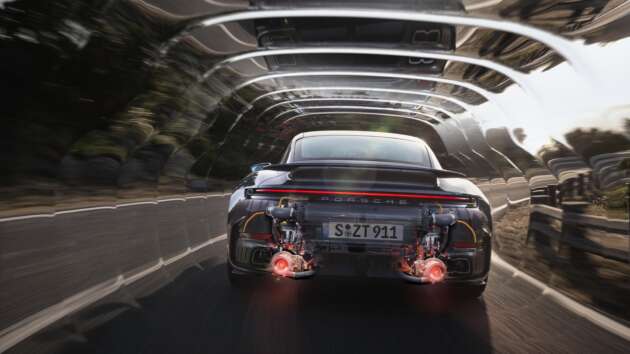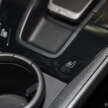The most powerful production 911 to date is described by Porsche as the superior all-rounder among sports cars. Meet the new Porsche 911 Turbo S, the range topper of the 992.2-generation 911 that has been unveiled at the IAA Mobility Motor Show in Munich.
Available as a coupe and cabriolet, the 911 Turbo S comes with significantly increased performance, a ‘more powerful design’, improved aerodynamics, an optimised chassis and more exclusive equipment.
“The 911 Turbo S is the most complete and versatile form of driving a Porsche 911. Whether in daily use, on long autobahn journeys or on the racetrack – we have made the new 911 Turbo S even more comfortable, more individual and significantly faster than its predecessor,” says Frank Moser, VP of the 911 and 718 model lines.
We’ll start with what’s chucked in the rear, which is now electrified like in the 911 Carrera GTS. That car has a single electric exhaust gas turbocharger (eTurbo) integrated into the 400V T-Hybrid system with a 1.9 kWh battery, but there are two eTurbos for the Turbo S, with a specially designed turbine and compressor. Going from one to two not only boosts max output, but improve responsiveness too, Porsche says.
The most powerful production 911 to date delivers 711 PS and 800 Nm of torque, with the latter available over a wide range of 2,300 to 6,000 rpm. The power curve of the 3.6L flat-six has a flat top of a peak – the full 711 PS – which by the way is 61 PS more than the previous 3.8L Turbo S – is available from 6,500 to 7,000 rpm.
The eight-speed PDK gearbox with an integrated electric motor transmits power to the all-wheel drive system, which helps the Turbo S Coupe get from 0-100 km/h in 2.5 seconds (a McLaren W1 needs 2.7 seconds), two tenths faster than before. 0-200 km/h takes just 8.4 seconds, half a second faster. Top speed is 322 km/h. For context, the GTS’ headline figures are 540 PS/610 Nm, 3.0 seconds and 312 km/h.

You’d expect the extra powertrain hardware to weigh more than 85 kg, but that’s the weight difference between the 992.2 Turbo S and its non-electrified predecessor. Porsche says that this beast lapped the Nürburgring Nordschleife in 7:03.92 minutes, which is around 14 seconds faster than the previous Turbo S.
Powertrain aside, the new Turbo S sports the latest tyres (Pirelli P Zero R provides significantly improved dry handling while maintaining good performance in the wet, Porsche says), 10 mm wider rear tyres (325/30 ZR 21, front 255/35 ZR 20 size unchanged), new brake pads for the standard Porsche Ceramic Composite Brake (PCCB) system (better performance and pedal feel) and larger rear discs (390 to 410 mm, front 420 mm unchanged). These are the largest ever PCCB brakes in a two-door Porsche.
Improved aerodynamics are derived from active, vertically arranged cooling air flaps at the front and an active front diffuser, together with an adjustable front spoiler lip and the extendable and tilting rear wing carried over from the previous Turbo S. Cooling air flows optimally to the brakes and radiators. The active aero reduces lift or, when retracted, drag, depending on the driving situation. Drag coefficient has been reduced by 10%.
Interestingly, Porsche says that the active aero improve wet braking performance – in wet mode, the front diffusers close to shield the front brake discs from excessive water spray.
There’s more. The T-Hybrid’s high-voltage electrical system and battery allowed Porsche to equip the new Turbo S with electro-hydraulically controlled Porsche Dynamic Chassis Control (ehPDCC) as standard.
This system reduces the tendency to roll when changing direction and increases agility when entering and exiting corners. The system works with cross-connected active coupling rods, in which pressure is built up by oil volume flow depending on the driving situation. The stabilisers generate support forces and keep the 911 in balance. This makes the car even more predictable and easier to drive despite the enormous power; comfort, stability and agility are all improved at the same time, Porsche says.
The electro-hydraulic PDCC is available with an optional lift system for the front axle. The previous car had this too, but here, it ‘acts much faster’ due to the 400V system integration. Finally, a new standard sports exhaust system with rear silencer and tailpipe trims made of titanium delivers a ‘more emotive sound’ together with engine tricks like asymmetrical timing. The exhaust system saves 6.8 kg, too.
We move on to aesthetics. The new Turbo S sees the introduction of Porsche’s cross-series Turbo design strategy in the 911. Contrasting elements are finished in Turbonite, a colour reserved for Turbo variants. You can find it on the Porsche crest, Turbo S lettering and new wheel centre-lock design. There are also Turbo S-specific inserts in the slats of the rear wing and the side window strips.
Turbonite accents are also found in the cabin, specifically on the door panels, steering wheel, dashboard and centre console surrounds, as decorative stitching, and on the Sport Chrono stopwatch and instrument cluster. The dark hue can also be found on the seatbelts and several buttons. Carbon-structured trim strips with neodyme trim and a perforated microfibre headliner with black backing make their debut.
Adaptive 18-way ‘Sports Seats Plus’ with memory function and “Turbo S” lettering on the headrests are standard. The Turbo S-specific embossing on the seat surfaces and door panels is a reinterpretation of the design features of the first 911 Turbo 930, Porsche says. If you want something more aggressive, the 911 GT3’s folding lightweight sports buckets is an option for the coupe.
By the way, the coupe is delivered as a two-seater, but one can have the rear seats fitted at no extra charge. The cabriolet comes in a 2+2 configuration. For customisation, the Porsche Exclusive Manufaktur range offers things like over 100 exterior colours, a visible carbon roof and even lightweight wiper arms made of carbon, which are 50% lighter.
You can also have a Porsche Design chronograph watch to match your ride. The Chronograph 911 Turbo S has a titanium case with black titanium carbide coating and is powered by the COSC-certified Porsche Design caliber WERK 01.200 with flyback function. The rotor can be customised to match the wheel design of your car, and the caseback can be engraved. Turbonite can be found here too, along with a strap made of original Porsche interior leather and yarn. Handmade to order in Grenchen, Switzerland.
GALLERY: 2026 Porsche 911 Turbo S ‘992.2’







































































































































































































































































































































